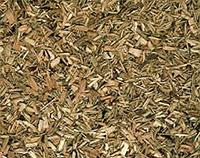
Engineered Wood Fiber (EWF) is an economical playground surfacing that is used on the majority of playgrounds in the United States. It has high impact absorbing qualities that when properly installed also offers a firm, slip resistant surface that meets accessibility guidelines.1
Made of processed wood that is ground to a fibrous consistency randomly sized typically to not over 2” in length, Engineered Wood Fiber is typically free of hazardous substances and twig and leaf material.2 Unlike wood mulch, EWF is made from the wood inside the tree, not using the bark. The small fiber pieces do not have sharp edges and splinters are not a problem.3 The natural wood is engineered to knit together and form a surface soft enough to cushion falls and also firm enough for wheelchairs to navigate the playground.4
Often Engineered Wood Fiber is chosen as a playground surface for its natural, rustic look, but the lower cost is the major consideration for most playgrounds. EWF is generally 10% to 15% the cost of synthetic rubber surfaces. When installed with proper drainage and well maintained, the life expectancy of the wood fiber surface will be at least 8 years and often longer.5
Engineered Wood Fiber is installed with a minimum depth of 9 inches in the playground equipment’s use zones depending on the height of the equipment. It is often distributed on top of a layer of landscaping fabric that has been placed over 3-4 inches of gravel to create a natural drainage system that will move the rain water away from the surface and extend the life of the EWF.6 The EWF can be contained with playground borders or landscape timbers for aboveground installation or the ground can be excavated to have the play area flush with the surrounding land.7
Since EWF is in a “fluffy” state when installed, it typically takes 2-6 weeks to compact during normal use and normal rainfall. Until it is compacted, the playground surface does not meet the needs for accessibility. The playground owner may choose to have the wood fiber compacted during installation. This requires more wood fiber, but the playground will be compliant with the Americans With Disabilities ACT (ADA) making it accessible when the playground construction is completed.8
Engineered Wood Fiber must meet or exceed ASTM International (ASTM) standards and U.S. Consumer Product Safety Commission (CPSC) guidelines. Specific standards are ASTM F1292 for impact testing, ASTM F2075 for purity and quality of the product, and ASTM F1951 for accessibility on the playground.9
Testing for impact attenuation of the surfacing dictates the depth of surfacing required to minimize injury from a fall. ASTM F1292 requires suppliers of playground surfacing to provide a copy of their testing done. To ensured continued compliance of the surfacing, field testing of the installed surface should be done within two years of installation.10
The cushioning properties of EWF can be maintained for the life of the playground provided the depth is maintained by occasionally topping off with fresh EWF. Occasional raking and tamping is necessary to keep the play area in good condition, depending on the amount of usage the playground has as well as other conditions, such as climate and the condition of the drainage system below the surface. Wear mats under high use areas help maintain accessibility and minimize maintenance.11 Wear mats can be placed on top of or just below the surface to provide stability and longevity for surfaces under swings, slide exits, and other play components where landing, dragging of feet, or other movement will cause surfacing to be displaced.12
New, cost-effective alternatives to traditional EWF have been developed called Stabilized Engineered Wood Fiber (SEWF). Stabilizing binders of urethane and an acrylic/polyvinyl-acetate polymer emulsion have been used to bond a thin top layer of EWF to form a resilient, yet stable, uniform surface. This allows for easy navigation for wheelchairs and walkers, while underneath, the EWF remains loose and provides cushioning for falls. These products are about the double the price of traditional EWF, but are still much less expensive than a rubber surface.13
- 1. “About Engineered Wood Fiber.” Zeager. < http://www.zeager.com/planning-resources/about-engineered-wood-fiber/ > 1 June 2016.
- 2. “Frequently Asked Questions about various types of playground surfaces.” IPEMA. < www.ipema.org/faqs/IPEMA_FAQ_Surfacing_022513.pdf > 1 June 2016.
- 3. “About Engineered Wood Fiber.” Engineered Wood Fiber. < http://engineeredwoodfiber.com/about-our-fiber/ > 1 June 2016.
- 4. “Engineered Wood Fiber.” Robertson Recreational Surfaces. < http://www.totturf.com/products/engineered-wood-fiber/ > 1 June 2016.
- 5. Laufenberg, Theodore, Andrzej M. Krzysik, and Jerrold E. Winandy. “Improving Engineered Wood Fiber Surfaces for Accessible Playgrounds.” American Trails. < http://atfiles.org/files/pdf/WoodFiberSurface.pdf > 1 June 2016.
- 6. Op. cit., “About Engineered Wood Fiber.” Engineered Wood Fiber.
- 7. Op. cit., “Frequently Asked Questions about various types of playground surfaces.”
- 8. “The compaction factor.” Zeager. Zeager Znews June 2016. < http://www.zeager.com/content/uploads/2016/05/NEW-August-compaction-factor.pdf > 1 June 2016.
- 9. Op. cit., “Frequently Asked Questions about various types of playground surfaces.”
- 10. Huber, Rolf. “Selecting Your Playground Surface.” Play and Playground Magazine. Fall 2015. < http://www.playgroundprofessionals.com/magazine/issues/2015/09/selecting-your-playground-surface209 > 1 June 2016.
- 11. Op. cit., “Frequently Asked Questions about various types of playground surfaces.”
- 12. Op. cit., “Engineered Wood Fiber.”
- 13. “Engineered wood fiber surfaces improve accessibility for Americans with disabilities.” American Trails. National Trails Training Partnership. < http://www.americantrails.org/resources/accessible/EWFsurface.html > 1 June 2016.

